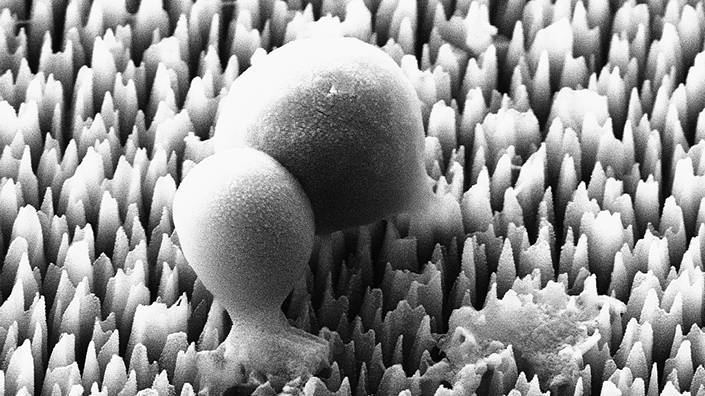Articles
More than 700,000 people die each year owing to drug-resistant bacterial infection. Over-prescribed antibiotics have become less effective over time, and ‘superbugs’ such as MRSA and C. difficile have developed resistance to many different types.
The issue is one of the greatest threats to global health, said Professor Elena Ivanova from RMIT University in Melbourne, Australia, and routine treatment of infection is becoming increasingly difficult.
Thankfully, Ivanova and colleagues have identified an unusual source for a potential solution – insect wings. Their surfaces have highly effective anti-bacterial systems, which are now being replicated to prevent the spread of infections.
“The self-cleaning effect of natural superhydrophobic surfaces such as lotus leaves and insect wings was known, however it was not clear how insect wings remain free of bacterial biofilms,” said Ivanova. “The motivation of our work was to design bacteria-free surfaces by creating synthetic analogues of natural surfaces.”
Replicating nanopillars
The research found that the wings of cicadas and dragonflies are covered in tiny ‘nanopillars’. Bacteria that land on them are pulled, stretched or sliced apart.
“During attachment onto the surfaces, bacterial cells are suspended on the nanopillars, so that the cell membrane is stretching so much that it breaks between the nanopillars,” said Ivanova. The structures were the first ‘nanopatterns’ replicated by scientists. They have since engineered other shapes such as sheets and wires.
Recent research from Ivanova’s team categorised the different ways that the patterns deliver the necessary mechanical forces to burst cell membranes, to help create better synthetic surfaces.
“The diversity of the nanofeatures that can be created on the material surfaces is remarkable,” she said. “What is even more amazing is that bacterial cells are killed differently depending on the dimensions of the nanopillars… if the surface features are sharp flakes, like graphene nano-sheets, the cell membrane is cut through, causing cell death.”
The team’s synthetic biomimetic nanostructures vary in their anti-bacterial performance, but it is not always clear why. The density, height and diameter of nanopillars are key, and need to be optimised to maximise bactericidal effects.

Golden staph bacteria being ruptured and destroyed by black silicon nanoneedles, an anti-bacterial surface inspired by insect wings. Image magnified 30,000-times (Credit: RMIT University)
A ‘new era’
Insect wings also use biochemical properties to damage bacteria, according to research led by Professor Bo Su at the University of Bristol. Using advanced imaging tools and other experimental methods, the team found that antibacterial properties are also the result of the “cumulative effects of physical impedance and induction of oxidative stress”.
“We found actually the mechanism is not just mechanical stretching,” said Su. “When the bacteria land on the spiky surface, they have some kind of film that generates free radicals that damage the bacteria.” The findings, published in Nature Communications, will help design better antimicrobial surfaces. Potential uses include medical implants that prevent infection, and devices that are not reliant on antibiotics.
Producing large volumes of nanostructured surfaces in a cost-effective way has been a significant challenge, but Ivanova said recent advances in nanofabrication technologies could open a “new era” of antimicrobial nanotechnology.
The work has so far focused on bacteria, but an increasing focus on viruses is likely in light of the Covid-19 pandemic. Although viruses are much smaller than bacteria, Ivanova said that surface nanofeatures could be optimised to kill viruses through simple mechanical rupturing.
Want the best engineering stories delivered straight to your inbox? The Professional Engineering newsletter gives you vital updates on the most cutting-edge engineering and exciting new job opportunities. To sign up, click here.
Content published by Professional Engineering does not necessarily represent the views of the Institution of Mechanical Engineers.